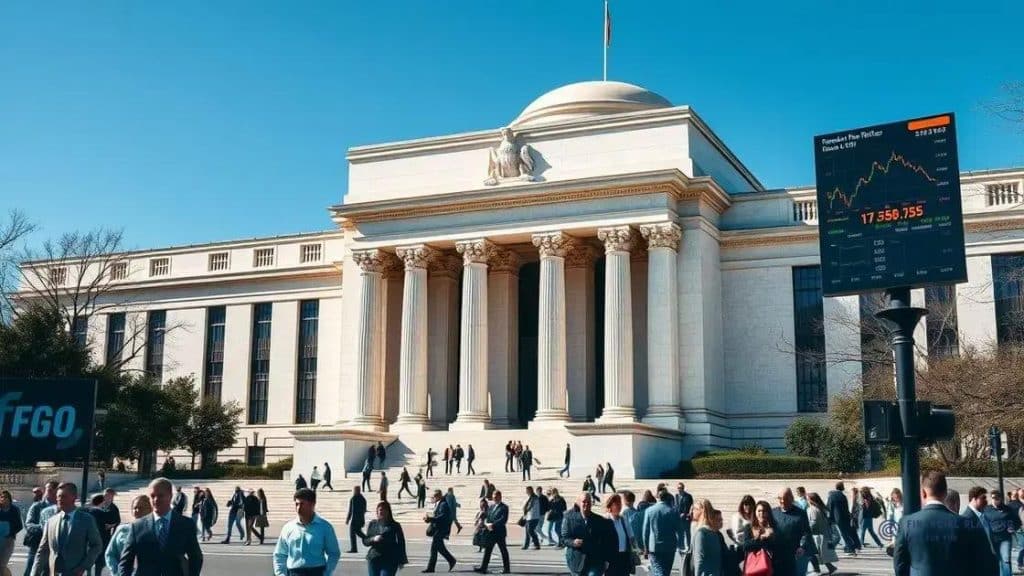Federal Reserve’s potential interest rate adjustments explained

The Federal Reserve’s interest rate adjustments directly impact inflation, employment, and economic growth, making it crucial for homeowners and businesses to understand these changes for informed financial decisions.
Federal Reserve’s potential interest rate adjustments play a crucial role in shaping the overall economy. As these rates fluctuate, they affect everything from loans to savings. Curious about what this could mean for you?
What factors influence the Federal Reserve’s decisions?
Understanding what factors influence the Federal Reserve’s decisions is essential for grasping how the economy operates. The Federal Reserve, or the Fed, takes into account various indicators to adjust interest rates and implement monetary policy.
Economic Indicators
The Fed closely monitors economic indicators to assess the health of the economy. These indicators include:
- Gross Domestic Product (GDP): This measures the overall economic activity and growth.
- Unemployment Rate: A low unemployment rate may prompt the Fed to raise rates.
- Inflation Rate: Higher inflation could lead to an increase in interest rates to stabilize prices.
These economic signals greatly influence the Fed’s decisions, as they strive for a stable economy.
Global Economic Conditions
The Fed also considers global economic conditions. Changes in international markets can have ripple effects domestically. For instance, if foreign economies are struggling, it might lead the Fed to keep rates lower to support growth. Global trade policies and tensions can further complicate these decisions, as the Fed must balance domestic and international interests.
Furthermore, the Fed evaluates financial markets. Stock market performance and bond yields can signal confidence or concern about the economy. If the markets react negatively to potential rate hikes, the Fed may reconsider its position.
By examining various data points, the Federal Reserve aims to make informed decisions that can help promote maximum employment, stable prices, and moderate long-term interest rates.
How interest rate changes affect inflation and employment

Understanding how interest rate changes affect inflation and employment is crucial for grasping monetary policy’s impact on the economy. When the Federal Reserve adjusts interest rates, it sets off a chain reaction that influences economic variables.
Impact on Inflation
Interest rates play a significant role in controlling inflation. When rates are lowered, borrowing becomes cheaper. This encourages consumers to spend more, which can drive prices up. In contrast, if the Fed raises interest rates, it can help to cool off an overheating economy by making loans more expensive. This usually slows down spending and investment, leading to lower inflation rates.
- Lower interest rates: Can lead to increased consumer spending.
- Higher interest rates: Tend to reduce demand and slow inflation.
- Long-term rates: Influence the overall cost of financial products and housing.
The relationship between interest rates and inflation is complex but critically important. As inflation rises, the Fed often feels pressure to increase rates to keep prices stable.
Effect on Employment
Employment levels are also impacted by changes in interest rates. Lower rates can stimulate hiring as businesses can borrow more easily. This funding allows companies to invest in projects and hire new employees. On the other hand, when the Fed raises interest rates, it can lead to slower economic growth and potentially higher unemployment rates.
For instance, if borrowing costs rise, businesses may hesitate to expand or hire more staff. As a result, there might be a slowdown in job creation. Maintaining a delicate balance between inflation and employment is a challenge for the Federal Reserve.
Understanding these dynamics helps individuals prepare better for economic changes and making informed financial decisions.
The impact of interest rate adjustments on homeowners
The impact of interest rate adjustments on homeowners is significant and multi-faceted. When the Federal Reserve changes interest rates, it sets off a chain reaction that can alter a homeowner’s financial situation dramatically.
Mortgage Rates
One of the most direct effects is on mortgage rates. When the Fed raises interest rates, mortgage rates tend to increase as well. Higher rates can lead to higher monthly payments for homeowners. This increase can make homeownership less affordable, especially for first-time buyers.
- Fixed-rate mortgages: Higher rates mean higher long-term costs.
- Adjustable-rate mortgages: Homeowners might face sudden increases in their payments.
- Refinancing options: Higher rates may discourage refinancing, locking homeowners into current rates.
As a result, potential buyers may decide to hold off on purchasing a home, which can impact the overall housing market.
Property Values
The housing market is sensitive to interest rate changes. As borrowing costs rise, demand for homes may decrease. This can lead to a slowdown in property value appreciation. Homeowners may find that their home’s value does not increase as expected, or worse, may decline in a higher interest environment.
Furthermore, when fewer people can afford to buy homes, it creates a buyer’s market, putting pressure on existing homeowners to lower their prices to sell. This scenario can lead to a decrease in equity for many homeowners, affecting their financial security.
Understanding how these changes impact your home is crucial. Homeowners should stay informed about interest rate trends to make sound decisions about buying, selling, or refinancing their properties.
How businesses respond to rate hikes or cuts

Understanding how businesses respond to rate hikes or cuts is crucial for predicting economic trends and making informed decisions. When the Federal Reserve changes interest rates, businesses must adapt their strategies accordingly.
Adjusting Spending and Investment
When interest rates rise, borrowing costs increase. This often leads businesses to reduce spending. Companies may choose to delay purchasing new equipment or expanding their operations. In contrast, when rates decrease, firms may find it cheaper to borrow money. This can result in increased spending on projects and hiring.
- Delayed Investments: Higher rates can halt plans for expansion.
- Increased Cash Flow: Lower rates allow for cheaper loans.
- Strategic Cuts: Businesses might cut unnecessary expenses to maintain margins.
These changes can significantly impact a company’s growth trajectory and market presence.
Pricing Strategies
Businesses also reassess their pricing strategies in response to interest rate changes. Higher borrowing costs can compel companies to raise prices for goods and services to maintain their profit margins. Conversely, if rates drop, businesses may have room to lower prices to attract customers, believing that increased demand could help offset their profit margins.
In addition, companies closely monitor consumer behavior. During times of higher interest rates, consumers may hold off on spending, leading businesses to adjust their forecasts and marketing strategies. Understanding customer sentiment is essential in these periods.
In summary, whether it’s through adjusting investment strategies or rethinking pricing policies, businesses must remain flexible in the face of changing interest rates. The ability to quickly adapt can be a significant factor in sustaining success.
Future outlook for interest rates and the economy
The future outlook for interest rates and the economy is a topic of great concern for both consumers and businesses. As economic conditions fluctuate, so do the decisions made by the Federal Reserve regarding interest rates. These decisions can shape the financial landscape for years to come.
Economic Indicators to Watch
Investors and analysts track various economic indicators that influence interest rate decisions. Key indicators include:
- Inflation rates: Rising inflation may prompt the Fed to increase rates to stabilize prices.
- Unemployment rates: A decrease in unemployment can signal economic growth, influencing rate decisions.
- Consumer spending: Changes in spending habits often impact inflation and growth forecasts.
These indicators provide valuable insights into how the Fed might respond in the future.
Predictions for Future Interest Rates
Experts often predict interest rate movements based on current economic trends. If inflation remains high, the Fed may continue to raise rates to combat it. Conversely, if the economy shows signs of slowing down, the Fed might lower rates to encourage borrowing and spending. This balancing act is crucial for promoting stable economic growth.
For homeowners and businesses, understanding the potential changes in interest rates can guide financial decisions. Anticipating when rates might rise or fall can inform choices related to mortgages, loans, and investments. Keeping an eye on the Fed’s announcements and the overall economic climate can provide a clearer picture of what lies ahead.
Ultimately, the future of interest rates will depend on the evolving economic landscape and how effectively the Federal Reserve navigates its policies.
FAQ – Frequently Asked Questions about Interest Rates and the Economy
How do interest rate changes affect homeowners?
Interest rate changes can significantly impact mortgage rates, which affects monthly payments and home affordability for homeowners.
What economic indicators should I watch regarding interest rates?
Key indicators include inflation rates, unemployment rates, and consumer spending, as these can influence the Federal Reserve’s decisions on interest rates.
How can businesses prepare for interest rate adjustments?
Businesses can analyze their spending habits and adjust investments and pricing strategies based on anticipated changes in interest rates.
What is the future outlook for interest rates?
The future of interest rates will depend on ongoing economic conditions, including inflation and consumer behavior, making it essential to stay informed.





